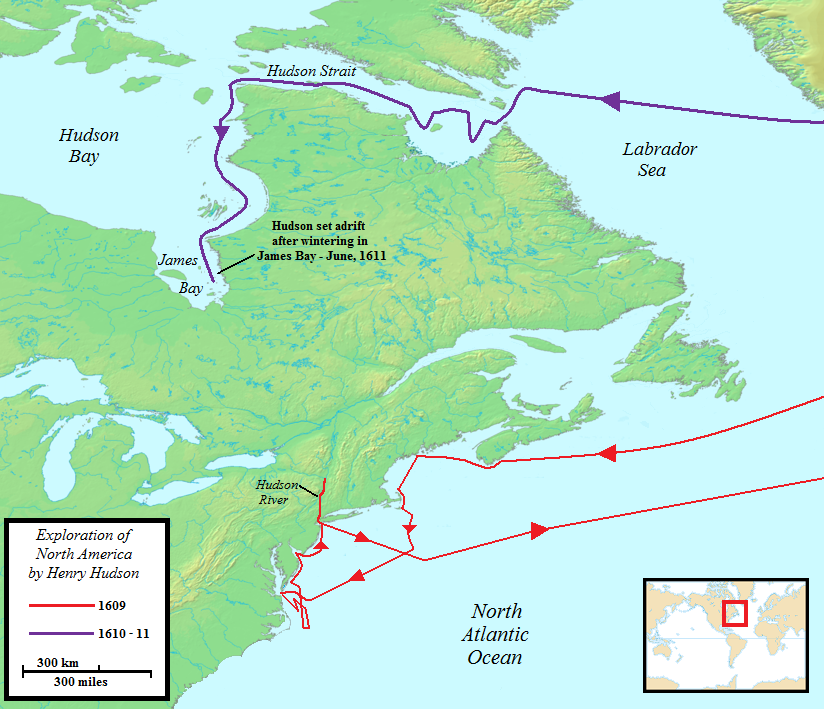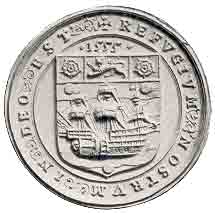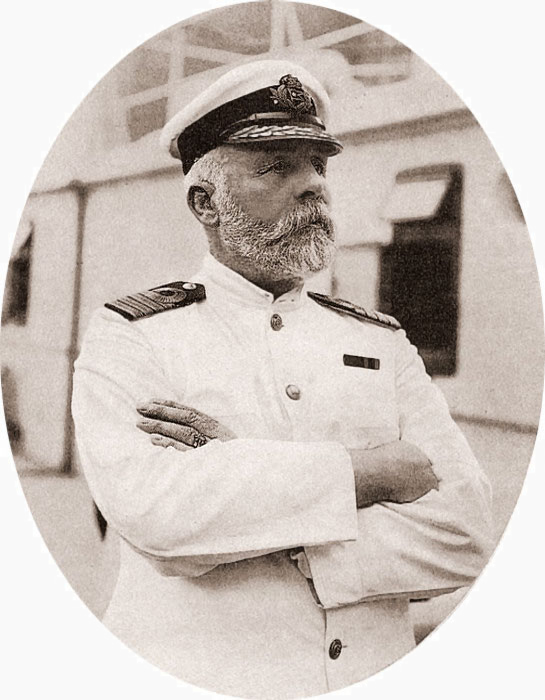|
Henry Hudson
Henry Hudson ( 1565 – disappeared 23 June 1611) was an English sea explorer and navigator during the early 17th century, best known for his explorations of present-day Canada and parts of the northeastern United States. In 1607 and 1608, Hudson made two attempts on behalf of English merchants to find a rumoured Northeast Passage to Cathay via a route above the Arctic Circle. In 1609, he landed in North America on behalf of the Dutch East India Company and explored the region around the modern New York metropolitan area. Looking for a Northwest Passage to Asia on his ship ''Halve Maen'' ("Half Moon"), he sailed up the Hudson River, which was later named after him, and thereby laid the foundation for Dutch colonization of the region. On his final expedition, while still searching for the Northwest Passage, Hudson became the first European to see Hudson Strait and the immense Hudson Bay. In 1611, after wintering on the shore of James Bay, Hudson wanted to press on to t ... [...More Info...] [...Related Items...] OR: [Wikipedia] [Google] [Baidu] |
Kingdom Of England
The Kingdom of England (, ) was a sovereign state on the island of Great Britain from 12 July 927, when it emerged from various Anglo-Saxon kingdoms, until 1 May 1707, when it united with Scotland to form the Kingdom of Great Britain. On 12 July 927, the various Anglo-Saxon kings swore their allegiance to Æthelstan of Wessex (), unifying most of modern England under a single king. In 1016, the kingdom became part of the North Sea Empire of Cnut the Great, a personal union between England, Denmark and Norway. The Norman conquest of England in 1066 led to the transfer of the English capital city and chief royal residence from the Anglo-Saxon one at Winchester to Westminster, and the City of London quickly established itself as England's largest and principal commercial centre. Histories of the kingdom of England from the Norman conquest of 1066 conventionally distinguish periods named after successive ruling dynasties: Norman (1066–1154), Plantagenet (1154–1485), Tudor ... [...More Info...] [...Related Items...] OR: [Wikipedia] [Google] [Baidu] |
Halve Maen
''Halve Maen'' (; en, Half Moon) was a Dutch East India Company '' vlieboot'' (similar to a carrack) that sailed into what is now New York Harbor in September 1609. She was commissioned by the VOC Chamber of Amsterdam in the Dutch Republic to covertly find a western passage to China. The ship was captained by Henry Hudson, an Englishman in the service of the Dutch Republic. In 1909, the Kingdom of the Netherlands presented the United States with a replica of ''Halve Maen'' to commemorate the 300th anniversary of Hudson's voyage; the replica was destroyed in a fire in 1934. Fifty years later, the New Netherland Museum commissioned a second replica. History ''Halve Maen'' sailed from Amsterdam to the Arctic, turning southwest to traverse the Atlantic Ocean to North America, then sailed from Newfoundland to the south in search of the Northwest Passage. In his 1625 book ''New World'', which contains invaluable extracts from Hudson's lost journal, Johannes de Laet, a director of ... [...More Info...] [...Related Items...] OR: [Wikipedia] [Google] [Baidu] |
Spitsbergen
Spitsbergen (; formerly known as West Spitsbergen; Norwegian: ''Vest Spitsbergen'' or ''Vestspitsbergen'' , also sometimes spelled Spitzbergen) is the largest and the only permanently populated island of the Svalbard archipelago in northern Norway. Constituting the westernmost bulk of the archipelago, it borders the Arctic Ocean, the Norwegian Sea, and the Greenland Sea. Spitsbergen covers an area of , making it the largest island in Norway and the 36th-largest in the world. The administrative centre is Longyearbyen. Other settlements, in addition to research outposts, are the Russian mining community of Barentsburg, the research community of Ny-Ålesund, and the mining outpost of Sveagruva. Spitsbergen was covered in of ice in 1999, which was approximately 58.5% of the island's total area. The island was first used as a whaling base in the 17th and 18th centuries, after which it was abandoned. Coal mining started at the end of the 19th century, and several permanent commun ... [...More Info...] [...Related Items...] OR: [Wikipedia] [Google] [Baidu] |
Hold With Hope
Hold with Hope is a peninsula in eastern Greenland. Administratively it is part of the Northeast Greenland National Park zone. Geologically Hold with Hope is a place of great interest. Geography Hold with Hope is located between Loch Fyne in the west, Godthab Gulf in the NW, Gael Hamke Bay in the north, the Greenland Sea at its eastern end, and Mackenzie Bay and Foster Bay on its southern side. The Spath Plateau, where the highest elevations are, is located in the northern part of the peninsula and the Tågefjeldene in the southern part. The Gauss Peninsula is located to the southwest, beyond the Badland Valley ''(Badlanddal)''. The section north of ''(Tobias Dal)'', a valley stretching from east to west across Hold with Hope, is also known as Home Foreland ''(Home Forland)''. History This peninsula was reported by English sea explorer Henry Hudson during his 1607 and 1608 voyage on the Muscovy Company 80-ton whaler ''Hopewell'' of Hull. It was the first definite recor ... [...More Info...] [...Related Items...] OR: [Wikipedia] [Google] [Baidu] |
Greenland
Greenland ( kl, Kalaallit Nunaat, ; da, Grønland, ) is an island country in North America that is part of the Kingdom of Denmark. It is located between the Arctic and Atlantic oceans, east of the Canadian Arctic Archipelago. Greenland is the world's largest island. It is one of three constituent countries that form the Kingdom of Denmark, along with Denmark and the Faroe Islands; the citizens of these countries are all citizens of Denmark and the European Union. Greenland's capital is Nuuk. Though a part of the continent of North America, Greenland has been politically and culturally associated with Europe (specifically Norway and Denmark, the colonial powers) for more than a millennium, beginning in 986.The Fate of Greenland's Vikings , by Dale Mackenzie Brown, ''Archaeological Institute of America'', ... [...More Info...] [...Related Items...] OR: [Wikipedia] [Google] [Baidu] |
Midnight Sun
The midnight sun is a natural phenomenon that occurs in the summer months in places north of the Arctic Circle or south of the Antarctic Circle, when the Sun remains visible at the local midnight. When the midnight sun is seen in the Arctic, the Sun appears to move from left to right, but in Antarctica the equivalent apparent motion is from right to left. This occurs at latitudes from 65°44' to 90° north or south, and does not stop exactly at the Arctic Circle or the Antarctic Circle, due to refraction. The opposite phenomenon, polar night, occurs in winter, when the Sun stays below the horizon throughout the day. Details Around the summer solstice (approximately 21 June in the Northern Hemisphere and 21 December in the Southern Hemisphere), in certain areas the Sun does not set below the horizon within a 24-hour period. Geography Because there are no permanent human settlements south of the Antarctic Circle, apart from research stations, the countries and territo ... [...More Info...] [...Related Items...] OR: [Wikipedia] [Google] [Baidu] |
Muscovy Company
The Muscovy Company (also called the Russia Company or the Muscovy Trading Company russian: Московская компания, Moskovskaya kompaniya) was an English trading company chartered in 1555. It was the first major chartered joint stock company, the precursor of the type of business that would soon flourish in England and finance its exploration of the world. The Muscovy Company had a monopoly on trade between England and Muscovy until 1698 and it survived as a trading company until the Russian Revolution of 1917. Since 1917 the company has operated as a charity, now working within Russia. Chancellor would function as the navigator of the small fleet, which consisted of three ships: the ''Bona Esperanza'' under Willoughby, the ''Edward Bonaventure'' under Chancellor and the ''Bona Confidentia''. The fleet departed from London on 10 May 1553, but near the Lofoten islands a storm hit the ships and separated Chancellor's vessel from the other two. Willoughby even ... [...More Info...] [...Related Items...] OR: [Wikipedia] [Google] [Baidu] |
Sea Captain
A sea captain, ship's captain, captain, master, or shipmaster, is a high-grade licensed mariner who holds ultimate command and responsibility of a merchant vessel.Aragon and Messner, 2001, p.3. The captain is responsible for the safe and efficient operation of the ship, including its seaworthiness, safety and security, cargo operations, navigation, crew management, and legal compliance, and for the persons and cargo on board. Duties and functions The captain ensures that the ship complies with local and international laws and complies also with company and flag state policies. The captain is ultimately responsible, under the law, for aspects of operation such as the safe navigation of the ship,Aragon and Messner, 2001, p.4. its cleanliness and seaworthiness,Aragon and Messner, 2001, p.5. safe handling of all cargo,Aragon and Messner, 2001, p.7. management of all personnel,Aragon and Messner, 2001, p.7-11. inventory of ship's cash and stores,Aragon and Messner, 2001, p.11-12. an ... [...More Info...] [...Related Items...] OR: [Wikipedia] [Google] [Baidu] |
Cabin Boy
''Cabin Boy'' is a 1994 American fantasy comedy film, directed by Adam Resnick and co-produced by Tim Burton, which starred comedian Chris Elliott. Elliott co-wrote the film with Resnick. Both Elliott and Resnick worked for '' Late Night with David Letterman'' in the 1980s as well as co-creating the Fox sitcom '' Get a Life'' in the early 1990s. Plot Nathaniel Mayweather ( Chris Elliott) is a snobbish, self-centered, arrogant, despicable, loathsome virginal man. After graduation, he is invited by his father to sail to Hawaii aboard the ''Queen Catherine''. After annoying the limo driver who is taking him to board the boat, he is forced to walk the rest of the way. Nathaniel makes a wrong turn into a small fishing village where he meets the imbecilic cabin boy/first mate Kenny (Andy Richter). He thinks the ship, ''The Filthy Whore'', is a theme boat. It is not until the next morning that Captain Greybar (Ritch Brinkley) finds Nathaniel in his room and explains that the boat will no ... [...More Info...] [...Related Items...] OR: [Wikipedia] [Google] [Baidu] |
Peter C
Peter may refer to: People * List of people named Peter, a list of people and fictional characters with the given name * Peter (given name) ** Saint Peter (died 60s), apostle of Jesus, leader of the early Christian Church * Peter (surname), a surname (including a list of people with the name) Culture * Peter (actor) (born 1952), stage name Shinnosuke Ikehata, Japanese dancer and actor * ''Peter'' (album), a 1993 EP by Canadian band Eric's Trip * ''Peter'' (1934 film), a 1934 film directed by Henry Koster * ''Peter'' (2021 film), Marathi language film * "Peter" (''Fringe'' episode), an episode of the television series ''Fringe'' * ''Peter'' (novel), a 1908 book by Francis Hopkinson Smith * "Peter" (short story), an 1892 short story by Willa Cather Animals * Peter, the Lord's cat, cat at Lord's Cricket Ground in London * Peter (chief mouser), Chief Mouser between 1929 and 1946 * Peter II (cat), Chief Mouser between 1946 and 1947 * Peter III (cat), Chief Mouser between 1947 a ... [...More Info...] [...Related Items...] OR: [Wikipedia] [Google] [Baidu] |
Cornell University Press
The Cornell University Press is the university press of Cornell University; currently housed in Sage House, the former residence of Henry William Sage. It was first established in 1869, making it the first university publishing enterprise in the United States, but was inactive from 1884 to 1930. The press was established in the College of the Mechanic Arts (as mechanical engineering was called in the 19th century) because engineers knew more about running steam-powered printing presses than literature professors. Since its inception, The press has offered work-study financial aid: students with previous training in the printing trades were paid for typesetting and running the presses that printed textbooks, pamphlets, a weekly student journal, and official university publications. Today, the press is one of the country's largest university presses. It produces approximately 150 nonfiction titles each year in various disciplines, including anthropology, Asian studies, biologica ... [...More Info...] [...Related Items...] OR: [Wikipedia] [Google] [Baidu] |
Hudson Bay
Hudson Bay ( crj, text=ᐐᓂᐯᒄ, translit=Wînipekw; crl, text=ᐐᓂᐹᒄ, translit=Wînipâkw; iu, text=ᑲᖏᖅᓱᐊᓗᒃ ᐃᓗᐊ, translit=Kangiqsualuk ilua or iu, text=ᑕᓯᐅᔭᕐᔪᐊᖅ, translit=Tasiujarjuaq; french: baie d'Hudson), sometimes called Hudson's Bay (usually historically), is a large body of saltwater in northeastern Canada with a surface area of . It is located north of Ontario, west of Quebec, northeast of Manitoba and southeast of Nunavut, but politically entirely part of Nunavut. Although not geographically apparent, it is for climatic reasons considered to be a marginal sea of the Arctic Ocean. It Hudson Bay drainage basin, drains a very large area, about , that includes parts of southeastern Nunavut, Alberta, Saskatchewan, Ontario, Quebec, all of Manitoba, and parts of the U.S. states of North Dakota, South Dakota, Minnesota, and Montana. Hudson Bay's southern arm is called James Bay. The Cree language, Eastern Cree name for Hudson an ... [...More Info...] [...Related Items...] OR: [Wikipedia] [Google] [Baidu] |






